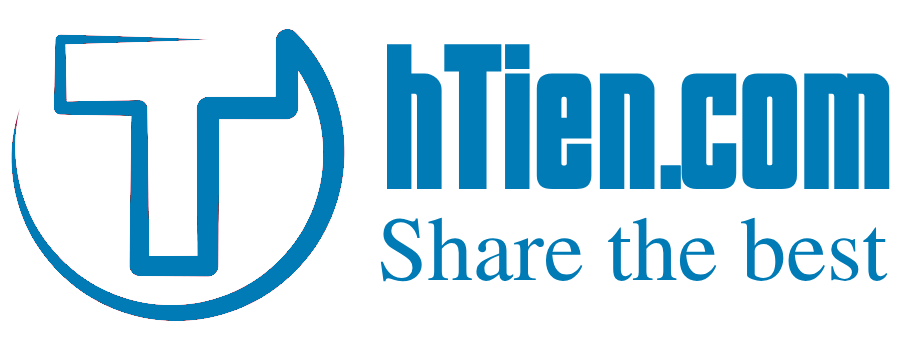Demand-side platforms in 2024 aren’t what they used to be just a couple of years ago — the evolution of digital advertising constantly brings new functionalities, ad formats, and capacities to the table.
Let’s review a list of demand-side platforms to compare the most popular options for ad management and buying.
Nội dung chính
13 best DSP companies of 2024
In programmatic advertising, DSP (a demand-side platform) is a technological platform that links advertisers and agencies to publishers willing to sell their ad space, typically on a per-click or per-impression basis.
We’ve selected the most popular DSPs that operate according to cost-per-impression models (in both self-service and managed service categories).
How we compared
While analyzing and comparing top demand-side platforms DSPs, we used builtwith.com and similartech.com to fetch the freshest results and traffic info.
Best DSPs for programmatic advertising: comparison table
| DSP | Ad types supported | Payment model | Top verticals | Targeting options | Top countries |
| 1. Amazon |
Display, audio, video. |
CPM | Sports, Electronics, Clothing, Games, Beauty & Personal Care, and others |
Demographic, device, contextual, behavioral, retargeting, and more |
US, Canada, Mexico, Brazil, UK, Germany, Spain, France, Italy, Netherlands, Sweden, Turkey, Saudi Arabia, UAE, Australia, India, Japan |
| 2. Google Display and Video 360 |
Display, video, audio, TV, DOOH |
CPM |
Arts & Entertainment, Food & Drink, Sports, Electronics, Finance, Hobbies & Leisure |
Demographic, geo, day and time, keywords, language, device, browser, category |
Across the world, only several locations are excluded |
| 3. Criteo |
Display mobile, tablet, desktop, display video, social, native, in-app ad formats, tablet formats, CTV |
CPM | Science & Education, Arts & Entertainment, Computers Electronics, Games |
IP, OS, geo, device type, traffic type, time of day, connection type, and more |
USA, UK, Canada, Germany, Spain, France, Australia, Brazil, Poland, Netherlands, Mexico, India |
| 4. Centro’s Basis |
Display, mobile, in-app, native, video, CTV, audio programmatic |
CPM |
Sports, Vehicles, Science & Education, Finance
|
Language, geo, Apps, Content, contextual targeting, retargeting |
US, UK, Canada, China, Mexico, Australia |
| 5. Xandr Invest |
Display mobile, display video, in-app, OTT, CTV, programmatic audio, mobile web, native |
CPM |
Arts & Entertainment, Computers Electronics, Technology, Science & Education, Games, and others |
Geo, Browser, Operating System, Language, contextual |
US, UK, Canada, Brazil, France, Germany, Australia, Italy, Netherlands, Spain |
| 6. Adelphic |
Display mobile, display video, programmatic audio, DOOH, CTV, in-app, mobile, web formats |
CPM |
Food & Drink, Health, Finance, Science & Education, Others |
Household IP address, unified cross-channel user ID |
US, Canada, UK, Mexico, Australia, Brazil, France |
| 7. Adform |
Video, display mobile web and in-app, OTT, CTV |
CPM |
E-commerce & Shopping, Vehicles, Computers Electronics, Sports |
Geo, browser, device OS, cookie ID, IP, interaction data |
US, Denmark, Spain, Poland, Sweden, Italy, Netherlands, Finland |
| 8. The Trade Desk | Display, mobile, in-app, native, video, audio |
CPM |
Arts & Entertainment, Games, Vehicles, Travel & Tourism |
Geo, browser, device OS, cookie ID, behavioral data |
US, UK, Australia, Canada, Germany, Japan, Brazil, France, Italy |
| 9. StackAdapt | Display, video, native, desktop, tablet, CTV, and mobile | CPM |
B2B, Finance, Government, Healthcare, Retail, and Travel |
Geo, Device ID, IP, browser, cookie ID |
US, Canada, UK, Brazil, Italy, Indonesia, Vietnam |
| 10. AcuityAds | Display, mobile, in-app, video |
CPM |
Arts & Entertainment, Science & Education, Games, Computers Electronics |
IP, OS, geo, device type, traffic type, time of day, connection type |
US, Canada, UK, Germany, Italy, Spain, Czech Republic, Brazil, Australia |
| 11. Mediamath’s TerminalOne | Display mobile, video, connected TV, programmatic audio, mobile formats, DOOH, native | CPM |
Vehicles, E-commerce & Shopping, Lifestyle, Computers Electronics |
Geo, site list, cookies, your own gathered first-party data, day part, technology category |
US, Brazil, Spain, UK, Canada, South Korea, Germany, France, Australia, Italy |
| 12. Adobe Advertising Cloud | Search, native, audio, display, video, CTV, DOOH | CPM |
Arts & Entertainment, Sports, Games, Electronics |
Audience segment, geo, OS, browser, device type, connectivity, and more |
Mostly global (depending on the SSP partners) |
| 13. SmartyAds | Video, banner, native, rich media, CTV, rewarded video, playable | CPM |
Business, Financial, Software, Employment, Consumer Electronics, Travel, Sports, Lifestyle and hobby, Media and entertainment |
Geo, OS, device & connection types, mobile carrier, browser & language, dayparting, frequency capping, Retargeting |
US, India, Israel, UK, Canada, Italy, France, Spain |
Amazon Ads
 Amazon, one of the largest online retailers, offers its own demand-side platform, which is available to digital media buyers who sell their products on Amazon and those who don’t.
Amazon, one of the largest online retailers, offers its own demand-side platform, which is available to digital media buyers who sell their products on Amazon and those who don’t.
Marketers can choose between managed- and self-service options. However, the managed service option normally requires a minimum spend of $50k, although this may vary according to the country.
Main features
- Multiple formats. You can launch display, audio, and video ads with the Amazon advertising platform. You can also create so-called device ads to reach customers on Amazon services and devices.
- Creative freedom. You can advertise with your own ads or leverage Amazon creative options (for instance, a video creative builder).
- Effective analytics. Your reports will include not only industry-standard metrics but also Amazon-specific metrics like add-to-list counts, detail page view rate, etc.
- Audience insights. You will be able to compare your insights with market research to identify new opportunities and get a better understanding of your audience.
- A/B testing. Your decisions regarding which ad to show will be data-driven.
Is it right for you?
Amazon is an undeniable giant in the e-commerce industry, and it offers ad inventory not only on Amazon itself but also on Amazon-owned and operated pages like Zappos, Audible, and others. This means that you will reach your audience across multiple platforms.
Another benefit is that you will be able to target users who have searched, viewed, or purchased specific items on Amazon. This can help you reach exactly those customers who are most likely to get interested in your offer.
The ads can be served in the US, Canada, Mexico, the UK, Germany, Spain, France, Italy, and other countries.
Google Display and Video 360
 Google’s marketing platform offers a Display & Video 360 solution for programmatic advertising. It is suitable for both small companies and enterprises. The solution includes five modules: Creatives, Campaigns, Audiences, Inventory, and Insights.
Google’s marketing platform offers a Display & Video 360 solution for programmatic advertising. It is suitable for both small companies and enterprises. The solution includes five modules: Creatives, Campaigns, Audiences, Inventory, and Insights.
This may sound rather complex, but Google offers training on using Display and Video 360.
Main features
- Cross-channel media planning. Google allows the creation of a comprehensive media plan and exploring inventory across both non-guaranteed and guaranteed buying types. The campaigns can be planned according to the predicted reach and frequency.
- Multiple ad formats. The available formats include display, video, audio, TV, and other types of programmatic ads. Besides, you can preview your ad designs in real time and build responsive ads.
- Audience management. Creating audiences from campaign data and leveraging audience lists from different sources is possible.
- Fraud prevention. Google detects and filters fraudulent impressions and even allows marketers to choose ad inventory where such impressions can be refunded.
- Numerous integrations. Display and Video 360 can be integrated with Analytics 360, YouTube, Google Cloud, and third-party exchanges.
Is it right for you?
At the moment, Google is the most popular search engine, so leveraging its programmatic advertising opportunities can help you reach your audience across different channels and virtually all over the world. Google ads are not served in certain countries, but this list is very limited.
Besides, the platform is continuously evolving, meaning that you can count on new features, products, and opportunities in the near future.
Criteo
 Criteo belongs to the top DSP companies because of its popular service called Criteo dynamic retargeting. This industry-leading solution serves ads across the globe (more than 1.2 billion yearly) and offers a platform for CPC and CPM-based campaigns.
Criteo belongs to the top DSP companies because of its popular service called Criteo dynamic retargeting. This industry-leading solution serves ads across the globe (more than 1.2 billion yearly) and offers a platform for CPC and CPM-based campaigns.
It is renowned for its strong display mobile, tablet, desktop, and display video capabilities. The platform features 725 daily active users and 35B daily browsing and buying events.
Main features
- Lots of ad formats. Display, mobile ads, tablet, desktop, banner ads, and display video campaigns (native video). Additional formats on offer include social, native, in-app ad formats, tablet formats, and CTV.
- Omnichannel reach. The single platform can deliver the ads across the most popular channels, including desktop, mobile, in-app, web mobile, and CTV ecosystems. The ads are dynamically optimized and suited to the platform and screen of the gadget.
- Strong and precise targeting. Dynamic retargeting demand-side platform DSP enables you to re-engage your customers on various devices and channels with multiple targeting options (IP, OS, geo, device type, traffic type, time of day, connection type, and more).
- Real-time reporting. You can generate on-demand reports according to the campaign performance criteria you choose.
- Premium publishers. Criteo’s open Commerce Marketing Ecosystem connects to myriads of premium-class publishers across the globe (with RTB and non-RTB deals).
Is it right for you?
Criteo is a solid data-driven solution for advertisers who want to run CPC and CPM-based campaigns. It was founded in 2005 and has accumulated a lot of valuable traffic by this time.
It is specifically good if you are looking for great display advertising capabilities and traffic sources. Aside from Criteo’s dynamic retargeting platform, they also have Criteo Direct.
The countries that they work with include top-tier areas like the USA, UK, Canada, Germany, Spain, France, and Australia. They also serve ads in Brazil, Poland, Netherlands, Mexico, India, and so on.
Centro (Basis)
 Centro’s Basis is the largest SaaS-based DSP advertising software that designed a self-serve platform for advertisers striving to buy digital inventory through real-time bidding RTB and programmatic direct deals.
Centro’s Basis is the largest SaaS-based DSP advertising software that designed a self-serve platform for advertisers striving to buy digital inventory through real-time bidding RTB and programmatic direct deals.
The Basis was founded in 2001, and to this day, it has a strong focus on omnichannel campaign delivery. This marketing platform is pretty much universal in its ability to serve all kinds of digital advertising campaigns; plus, it has over 2000+ active private deals. Basis features 1,836,034 daily impressions and 180 data points for targeting.
Main features
- Direct deals and RTB. A single interface opens a gateway to over 2000+ active private deals and real-time bidding RTB opportunities: advertisers can target audiences across all supply sources within the real-time bidding RTB ecosystem.
- Smart workflow automation. Artificial intelligence and machine learning algorithms at the core of the software platform automatically measure and optimize campaigns, from bid formation to prices and ad delivery.
- Variety of available ad formats. Social media, native advertising (native video), video advertising, display mobile, display video, CTV, audio programmatic. They are served in all resolutions (size, width, etc).
- Data-driven smart targeting. This marketing platform has 25,000+ audience segments that become available for targeting.
- Smart analytics. The in-built reporting system analyzes campaign performance according to the most important indicators in real time. As well, the reports can be saved and downloaded for further use.
Is it right for you?
Centro’s Basis is one of those demand-side platforms that will suit you if you strive to buy ad inventory in both RTB and direct, avoiding auctions. Aside from all the features listed above, the platform has traffic safety guarantees and protection mechanisms in place.
It functions according to the CPM pricing model and, thus, will better suit those advertisers who plan to run branding campaigns. According to similartech.com, their top verticals include Sports, Vehicles, Science & Education, and Finance. Top countries: US, UK, Canada, China, Mexico, Australia, etc.
Xandr (Microsoft advertising)
 Xandr Invest is a popular ad-buying platform created by AT&T in 2018 (previously called AppNexus, a global ad tech company). This demand-side platform DSP has a strong focus on desktop and mobile video and programmatic TV ad inventory (including OTT and CTV).
Xandr Invest is a popular ad-buying platform created by AT&T in 2018 (previously called AppNexus, a global ad tech company). This demand-side platform DSP has a strong focus on desktop and mobile video and programmatic TV ad inventory (including OTT and CTV).
This platform allows advertisers to reach up to 90% of Smart TV households. It is positioned as a premium-class software that enables advertisers to achieve great advertising outcomes through access to exclusive inventory, data management, powerful statistics, and precise targeting.
Main features
- Data-driven strong targeting. While targeting, advertisers can count on extensive 2,500+ audience segments that have been accumulated by Xandr based on their gathered top-class first-party data.
- The abundance of cross-channel ad formats. Display mobile, display video 360, in-app, OTT, CTV, programmatic audio, mobile, and native (native video). All these formats are impeccably rendered in all necessary environments and can be served in all suitable resolutions.
- Real-time attribution for campaigns. This platform has a strong reporting system that generates stats in digestible and visualized bites so that performance is delivered at a glance.
- Targeted ads across segments. Xandr is one of the top demand-side platforms because it operates based on valuable proprietary first-party data. You can find audiences based on geo, browser history, operating system, language, contextual targeting, retargeting, etc.
- Brand safety and protection. Xandr’s traffic is thoroughly monitored and scanned to prevent ad fraud and invalid traffic. All impressions are 100% viewable, thanks to integration with traffic safety providers.
Is it right for you?
Xandr Invest is one of those demand-side platforms that will be a perfect choice if you look for top-notch quality traffic, as it works with reputable publishers worldwide and uses its own first-party data audience segments.
Their support has a people-based approach, as they can guide advertisers through all stages of campaign management. With such capability, this online advertising platform can offer unique audience targeting options.
It will also be a great choice for desktop, mobile video, and CTV advertisers as the platform has enough traffic in these segments.
Adelphic
 Adelphic started conquering the digital marketing and advertising ecosystem in 2010 when Viant launched its demand-side platform DSP with cross-channel capabilities.
Adelphic started conquering the digital marketing and advertising ecosystem in 2010 when Viant launched its demand-side platform DSP with cross-channel capabilities.
The platform offers features and controls that help advertisers aptly find their audiences online and address them with relevant and individualized targeted messages. What’s unique about them is that they also offer data-driven single-user ID identification for targeting (instead of cookies).
Main features
- Portraits of real customers. You can target audiences according to their portraits that the system assembles across channels and devices and unifies into single IDs suitable for the most precise targeting.
- Omnichannel reach. Adelphic makes digital advertising available through RTB deals that span channels and all popular formats, including programmatic TV.
- Universal ad formats. When it comes to formats, Adelphic supports display mobile, video, programmatic audio, digital out-of-home, CTV, in-app, mobile, custom, and many others.
- Flexible and individual pricing. The platform offers to craft individual transparent pricing contracts with clients (based on their objectives and budget capacities).
- Custom reporting. Real-time reporting provides insightful attribution across channels. Custom reporting tools are available in the system.
Is it right for you?
Adelphic is a very powerful self-serve platform with a variety of functions for setting cross-channel campaigns. It is also a demand-side platform that is very convenient for advertisers looking for cookieless targeting capabilities based on unified cross-channel user IDs.
This solution also stands out in the demand-side platform list, offering relatively new programmatic advertising formats. This can be the best choice if you search for rare formats such as audio programmatic, CTV, and digital out-of-home.
Adform
 Established in 2002 in Denmark, Adform is here to offer a full ad tech stack for advertisers, agencies, and brands looking for advanced programmatic digital advertising capabilities.
Established in 2002 in Denmark, Adform is here to offer a full ad tech stack for advertisers, agencies, and brands looking for advanced programmatic digital advertising capabilities.
This DSP offers plenty of useful tools and perks, from quick campaign approval to automated campaign optimization, that make your campaigns very profitable. You can also count on a pretty broad reach — find your target audience across desktop, mobile, and tablet devices and top-quality traffic from their third-party vendors — Bid Switch, Oath Xandr, Pubmatic, OpenX, Rubicon, Teams, etc.
Main features
- KPI-driven system. The system has 14 in-built algorithms, each of which is designed to facilitate advertising KPI achievement. There is a bidding optimization, which means that the bid sum is adjusted so that it singles out only relevant impressions at the optimal price.
- Ad formats for all channels. Display and video digital advertising, mobile and in-app, OTT and CTV — there are lots to choose from if you want to enrich your media mix.
- Real-time reporting. The reports can be generated in real-time and on demand — just choose the performance criteria and make a report.
- Broad reach. RTB connection and integration with the largest traffic partners ensures that advertisers reach and buy the best inventory across the globe.
- Only healthy traffic. The platform generates only healthy, 100% viewable traffic that is free from bots and other ad fraud threats. Top countries include the US, Denmark, Spain, Poland, Sweden, Italy, Netherlands, and Finland.
Is it right for you?
The peculiar feature of Adform is that this digital advertising platform offers automatic campaign optimization as well as automatic bidding-improving.
It is one of those demand-side platforms that can be a good choice, especially if you want to obtain good-quality traffic in high volumes and across the channels. The stable traffic flow is guaranteed by connection to RTB and renowned ad tech vendors and partners.
The Trade Desk
 This self-serve digital advertising platform was founded in 2009, and by this time, it managed to gather a strong and reliable network of 225+ partners, including Hulu, Disney, ABC, Spotify, Pandora, FOX, and ESPN. With cross-channel capabilities, this DSP encourages advertisers to launch ad campaigns on a multitude of devices and screens, including cord-cutting CTV.
This self-serve digital advertising platform was founded in 2009, and by this time, it managed to gather a strong and reliable network of 225+ partners, including Hulu, Disney, ABC, Spotify, Pandora, FOX, and ESPN. With cross-channel capabilities, this DSP encourages advertisers to launch ad campaigns on a multitude of devices and screens, including cord-cutting CTV.
Main features
- RTB, PMP, guaranteed, and direct deals. Connection to RTB ensures the broadest reach and quick automated inventory purchasing. Direct, PMP, and guaranteed deals are also available.
- Great selection of ad formats. Currently, the platform has a focus on cord-cutting video advertising enabled by programmatic TV. Aside from CTV, there are native (native video), display mobile, social media ads, and programmatic audio. In the dashboard, advertisers can select the right width, height, and SD resolutions.
- Full-funnel attribution. The reporting system allows advertisers to analyze digital advertising performance from the impression to conversion stages. The reports are visualized, customized, and generated in real-time on demand.
- Expert dedicated support. This platform has a people-based approach — an expert support team is on board to assist advertisers and advise them regarding how to adjust their campaigns for success.
- Top-notch quality traffic. Traffic quality monitoring systems, along with proven supply-side names and partners, are key factors that guarantee traffic quality and great volumes.
Is it right for you?
This is a platform that can suit both programmatic advertising professionals and newbies (since it has a people-based approach and employs experts in the support team).
It has all the necessary functionalities and tools to help advertisers achieve great media trading results: RTB, cross-channel reach, and strong analytics and data management. What sets it apart from the rest of the best DSP platforms is advanced customer support and a variety of deals to choose from — RTB, direct, PMP, and guaranteed programmatic.
StackAdapt
 StackAdapt DSP belongs to the fastest-growing ad tech companies, namely — it ranks 6th in Deloitte’s Technology and comes 23rd in Fast 500 in North America.
StackAdapt DSP belongs to the fastest-growing ad tech companies, namely — it ranks 6th in Deloitte’s Technology and comes 23rd in Fast 500 in North America.
When it was founded (in 2013), the main purpose of the platform was to empower advertisers and agencies with strong software that automates media purchasing and optimizes bidding on the go. This DSP has an extensive network of partners, 500+ publishers, and 23 vertical coverage.
Main features
- Functionality for ad campaign planning. The platform has a creative studio to test campaigns before the launch, as well as a ‘planner’ to get access to the potential of data-driven campaigns. The ad previewer enables advertisers to evaluate the performance beforehand.
- Cross-channel ad formats. With all available ad formats, advertisers can launch video ad campaigns, native (native video), desktop, tablet, CTV, and mobile (for mobile marketers).
- Real-time campaign optimization. The bids are automatically adjusted by smart algorithms to hit the most valuable impressions at suitable ad slots.
- Campaign effectiveness measurement. Real-time MA and AI-powered reports can be scheduled and customized to deliver precise results regarding performance.
- The broadest reach of verticals. The ad platform provides traffic across more than 23 popular verticals, including B2B, finance, government, healthcare, retail, and travel.
Is it right for you?
StackAdapt falls within this demand-side platform DSP list because it has all the distinctive features of well-equipped modern software for ad buying. It is connected to the best global supply-side platforms via RTB and is integrated with worldwide traffic partners to ensure that they satisfy the needs of advertisers.
This platform can be especially good for experienced advertisers and brands as this self-serve software has advantageous tools for campaign testing, planning, and analysis.
AcuityAds
 AcuityAds was founded in 2009 in Toronto. This DSP is notoriously well-fitted to optimize the advertiser’s budget costs while delivering holistic ad campaigns to the viewers.
AcuityAds was founded in 2009 in Toronto. This DSP is notoriously well-fitted to optimize the advertiser’s budget costs while delivering holistic ad campaigns to the viewers.
It operates based on machine learning and artificial intelligence algorithms that make decision-making regarding each impression optimal. With advanced campaign controls, the platform allows advertisers to amplify their reach and achieve KPI results easily.
Main features
- Intuitive dashboard. The dashboard is designed to simplify ad campaign setup and maintenance. Simple drag-and-drop logic turns complicated processes into simple tasks.
- Advanced visualized experience. Aside from ad broadcasting, the platform is suited to deliver digestible insights to advertisers. How the ads are delivered regarding customer journey — it is possible to map up and create the alternate journey based on them.
- Consumer valuing tool. The platform implemented advanced technology that evaluates each potential customer toward the business goal (to define relevance and eliminate waste).
- Media mix assessment. How your ad investments perform, how they impact your audiences, and how they are allocated — all these things get visualized by the platform.
- Advanced performance evaluation. Actionable performance stats can be generated on demand in real time.
Is it right for you?
AcuityAds is well-adjusted to serve self-service programmatic advertising campaigns. The dashboard is clear and straightforward with drag-and-drop logic, still, it has lots of useful functions for sophisticated campaign management and navigation.
This option belongs today to the top DSP platforms because it offers unparalleled reach to advertisers, as well as intelligent mechanisms that make programmatic ads relevant and adjust ad messages throughout the customer journey.
MediaMath TerminalOne
 MediaMath TerminalOne DSP was founded in 2007 in New York. It has one of the largest networks of supply partners and is actively used by more than 4,000 advertisers in New York and worldwide.
MediaMath TerminalOne DSP was founded in 2007 in New York. It has one of the largest networks of supply partners and is actively used by more than 4,000 advertisers in New York and worldwide.
Overall, MediaMath is listed as a company that is trusted by two-thirds of Fortune 500 companies. The main feature that distinguishes this solution is that it prides itself on brand safety and transparency.
Main features
- Lots of cross-channel formats on offer. Display mobile, video, connected TV, programmatic audio, mobile formats, DOOH, and native. All creatives are automatically fitted to the screen and dynamically optimized with DCO technology.
- Strong targeting. The ads can be delivered in accordance with geo, site list, day part, technology category, and video/audio targets.
- Customer segmentation. The platform features a deep customer segmentation tool that ties together the first- and third-party data from partners of MediaMath. This functionality helps to create meaningful and relevant audiences for your programmatic campaigns.
- Brand image protection. The platform ensures that brand image is protected during the programmatic buying: privacy, fraud controls, and placement verification are in place.
- Precise analytics and data management. The platform has an in-built analytics and data management system that delivers performance stats on demand in easy-to-understand and convenient reports.
Is it right for you?
MediaMath is one of those demand-side platforms that can offer plenty of options to advertisers when it comes to formats. Like no other platform, it optimizes creatives of various sizes and formats and even serves digital out-of-home ads.
Apart from this distinctive feature, it can be right to say that this DSP will suit both experienced advertisers and newcomers since it also has a strong support team.
Adobe Advertising Cloud
 Adobe offers several advertising products, and one of them is a demand-side platform supporting cross-channel and cross-screen integration. It is an end-to-end solution, but you can also benefit from additional efficiency tools (like Adobe Sensei).
Adobe offers several advertising products, and one of them is a demand-side platform supporting cross-channel and cross-screen integration. It is an end-to-end solution, but you can also benefit from additional efficiency tools (like Adobe Sensei).
Thanks to its AI and ML framework, you can optimize your campaigns and drive even better results.
Main features
- Omnichannel advertising. You can launch search, native, CTV, audio, native video, display, and DOOH campaigns.
- Personalization. In combination with the Creative Management platform and other Adobe advertising products, you do not simply buy ad inventory but create and launch highly personalized ads.
- Advanced analytics. To make informed decisions and optimize campaigns, you can use real-time in-dash reporting, raw activity logs, custom reports, and reporting APIs.
- Brand safety. The platform detects fraudulent inventory across video and display. Besides, you can activate third-party integrations to ensure additional security.
- A/B testing. With this feature, you can test your audience, creatives, frequency, etc.
Is it right for you?
Adobe Advertising Cloud DSP has all the essential features, and you can learn more about it by requesting a demo. Besides, it is integrated with numerous leading SSPs, which allows you to serve ads globally.
The platform also provides loads of resources to help you understand how to use it and has an active community of users, so you are welcome to ask questions and learn from their experience.

SmartyAds DSP
 SmartyAds DSP is a leading full-stack programmatic advertising solution that has all essential functionalities for managing and raising profitable ad campaigns.
SmartyAds DSP is a leading full-stack programmatic advertising solution that has all essential functionalities for managing and raising profitable ad campaigns.
This software platform has been gradually augmenting the number of traffic sources so that it now serves 366,847 impressions daily. The average CTR indicator is 5,48%, and the CPM is around $1,01. This platform also has strong traffic protection mechanisms and is GDPR/CCPA compliant.
Main features
- Cross-device omnichannel delivery. SmartyAds DSP supports formats that suit all popular ad mediums: mobile, in-app, and CTV ecosystems. The formats are specifically suited for all device types.
- The abundance of formats. The number of digital ad formats that SmartyAds DSP supports is overwhelming: native, rich media, display mobile, native video (native video audio campaigns) banner, CTV, custom, and IAB format sizes and resolutions are also supported.
- Real-time bidding, direct, and PMP deals. Real-time bidding enables the broadest reach across countries. Advertisers who want to fetch exclusive and premium ad space can be traded directly with publishers or private marketplace auctions.
- 30+ options to target audience. Advertisers can address audiences according to their geolocation, language, age, gender, OS, device type, and other conditions to make ad serving relevant and personalized. The top verticals are Arts & Entertainment, Technology & Computing, Hobbies & Interests, Society, Business, News, Edu, Health & Fitness.
- Automated reporting. The stats regarding campaign performance can be generated on demand in convenient reports.
Is it right for you?
We’ve attributed SmartyAds to the top DSP platforms because it really has plenty of things to offer for advertisers. It will be a great choice for advertisers and agencies that are looking for a great global advertising reach, yet it is also good for those who want their options open for PMP and direct deals.
Their traffic comes from top-tier countries like the United States, India, Israel, Canada, Italy, France, Spain, the UK, and so on. It has a people-based approach, meaning that apart from a self-served platform, it can offer managed service.
How DSPs are different from ad exchanges and ad networks
Let’s see how demand-side platforms are different from multiple ad exchanges represented on the market today.
Ad networks
Typically, a key function of ad networks and ad exchanges is to aggregate the digital advertising inventory from publishers and align it with the advertiser’s demand.
Publishers of blogs, news sites, mobile apps, and websites collect their ad slots that advertisers can buy. Multiple ad exchanges may offer different traffic.
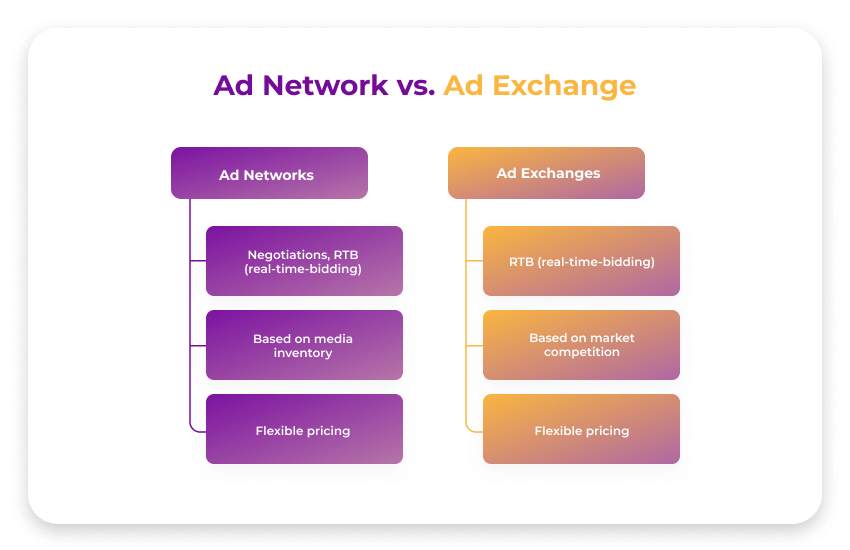
The other options may work specifically with display video, display mobile, native advertising, CTV ad campaigns, and so forth. Some think there’s an ongoing battle called DSP vs ad network.
The only difference is that the DSPs are designed only for the demand side. The network may also have real-time bidding RTB functionality. However, it can be joined by both demand and supply-side.
Ad exchanges
An ad exchange is an open marketplace designed for both supply and demand-side partners. Along with ad networks, they were the first online advertising platforms that popped into the scene.
Just like demand-side platforms, an ad exchange can also be used for buying digital advertising space based on targeting criteria.
The difference
The key difference here is that ad exchange is used by everyone, advertisers and publishers, while DSP demand-side platforms serve the interests of advertisers.
Since the demand-side platform DSP is an advertising platform designed for advertisers only, it leaves room for DSP companies to compete through more refined dashboard customization and a broader set of useful demand-side functionalities.
As well, advertisers can serve marketing and campaigns on DSP demand-side platforms through trading desks.
4 key features of a demand-side platform DSP
Choosing the right media buying platform may seem to be a challenging process, so here is the list of the core features to look for:
Cross-platform and cross-device digital advertising capabilities
- One person typically has several devices, each of which can function on different OS — mobile phone, laptop, PC. As CTV and OTT enormously grow, advertisers also strive to capture previously unexplored Smart TV audiences on demand-side platforms. Media buying on any marketing platform today should utilize AI, machine learning, and first/third-party data-driven advanced attribution algorithms that run cross-platform and cross-device advertising campaigns.
Healthy traffic and a safe advertising ecosystem
- If you are looking for the best DSP platform, you’ll need to look at how many ad exchanges the DSP has access to because it means greater reach. However, working with more traffic sources also entails more risks of advertising fraud unless a demand-side platform DSP has traffic protection scanners and filters in place. If demand-side platforms have proper anti-fraud control, it will directly affect the effectiveness of advertising campaigns, as impressions will only be seen by real people (not bots).
Lots of ad formats and profound analytics
- These days, it is a must for a demand-side platform DSP to support all formats, at least those that are very popular, such as native, display mobile ad, video, rich media, social media, etc. The more formats an online advertising platform can serve, the more opportunities are here to effectively embrace various channels. The reporting on DSPs should be generated on demand and include details of all primary variables used for targeting.
Compliance with international and local privacy regulations
- In light of the recent transformations related to privacy and user data protection, it becomes necessary for the demand-side platform and media buyers to be compliant with regulations and laws. DSPs use cookies and data management platforms that can be restricted by international regulations, GDPR and CCPA, and local ones. The best way is to ask your technology company whether it is compliant and what mechanisms they use to ensure this compliance.
What will define the best DSP platforms in the future?
The demand-side platforms list featured here counts the most popular options and the functions that may come in handy for advertisers in 2024. At the same time, the digital marketing and advertising scene is slowly leaning towards transparency and greater security.
Why demand-side platforms change
The massive introduction of an in-house programmatic advertising process encouraged businesses to create their own real-time bidding solutions.
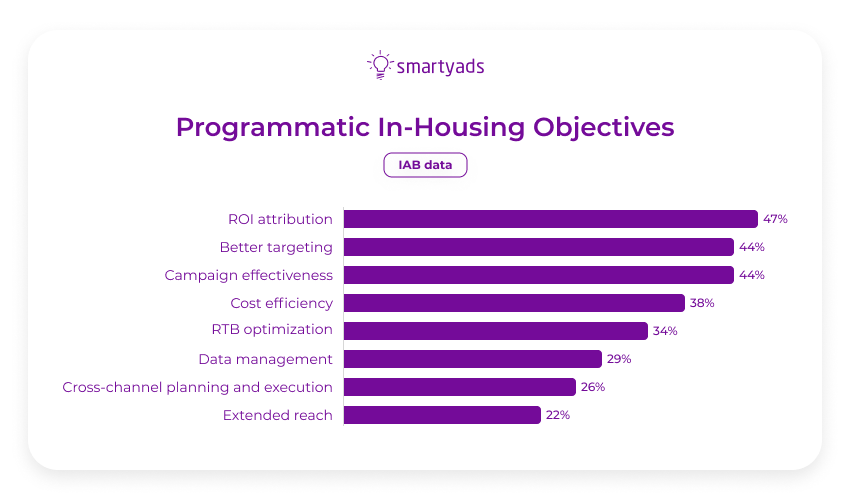
Still, digital marketing, advertising, and media buying require substantial resources, and bringing them in-house is something that big brands like Kellogg, IBM, or Unilever can afford.
To simplify independent programmatic advertising technology development, ad tech brought white-label business concepts to the table.
Alternative demand-side platforms as market drivers
While label DSP is the same programmatic advertising technology as regular DSP. An advertiser, in this case, buys the entire pre-built core of the platform, slightly customizes and labels it, and gears on the market as a new solution.
Such a model enables brands to build their own programmatic advertising technology in a week. The coding, designing, testing, and licensing parts of the equation are solved.
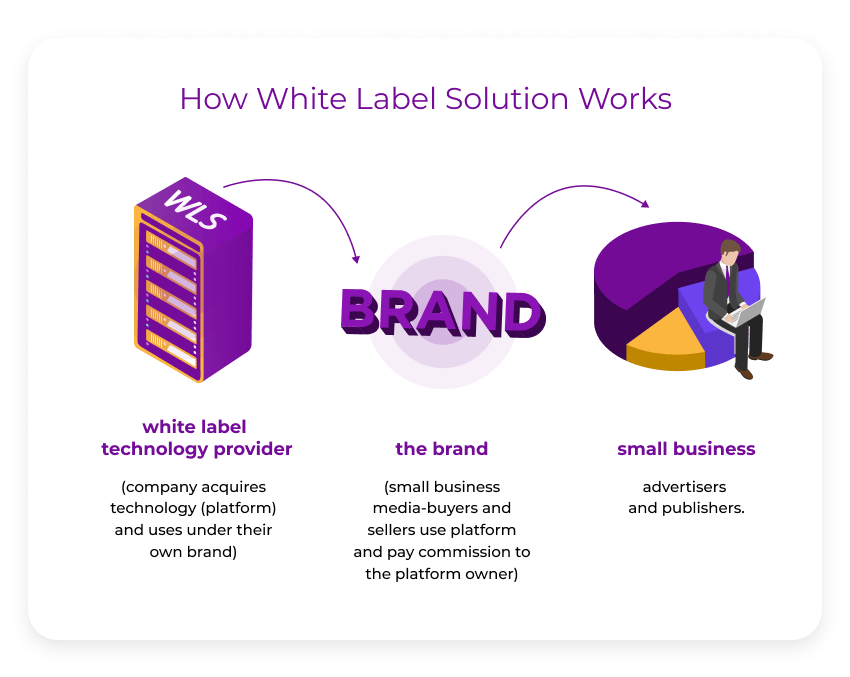
WL DSP from SmartyAds
Such demand-side platforms are ready to be launched in less than a month, and there are no risks of ending up with crude programmatic advertising solutions that fail to meet high-quality criteria. No need to rely on third-party service providers.
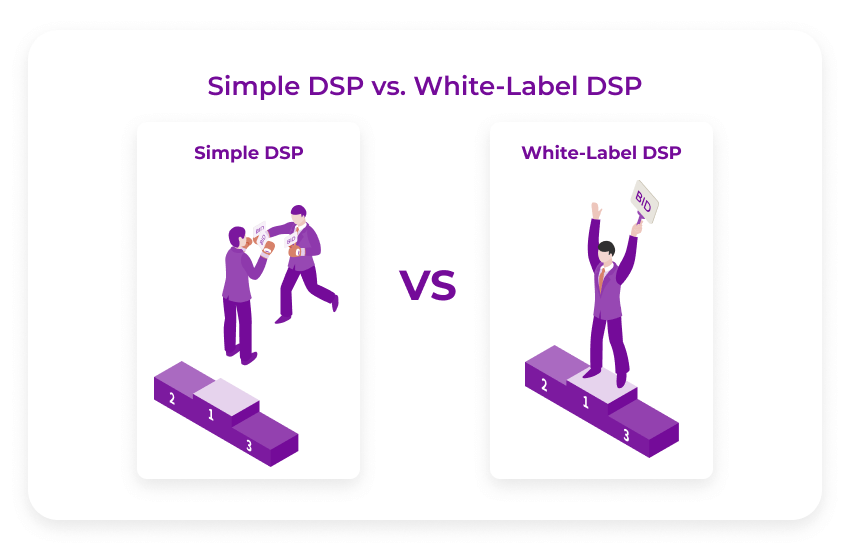
Award-winning white label solutions like SmartyAds DSP have all complex processes “under the hood” and don’t require specific tech knowledge.
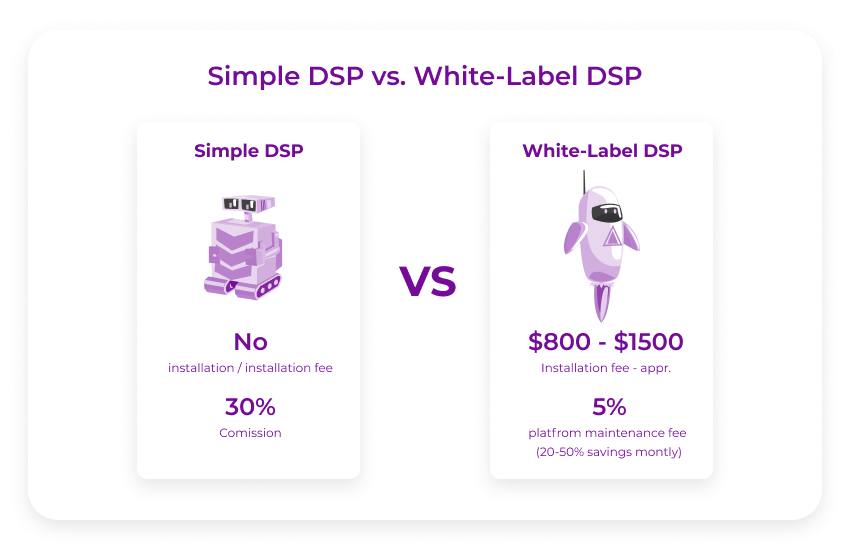
It has a strong RTB bidder, profound targeting capabilities, traffic navigation tools, and an intuitive, easy-to-navigate purchasing interface that makes media buying efficient and profitable.
These are the benefits that you will receive if you start your own advertising solution based on SmartyAds DSP.
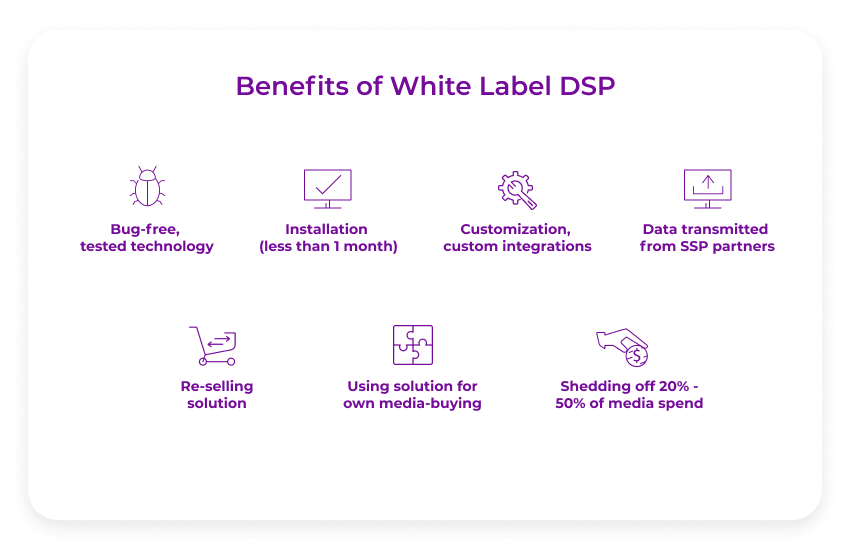
To sum up
How to choose a demand-side platform or any other digital advertising software platform in 2024? The best DSPs of 2024 are those that provide advertisers and media buyers with the broadest reach and essential functionalities for launching, managing, and analyzing their programmatic ad campaigns. Today, media buying algorithms on these platforms are based on machine learning, artificial intelligence, and smart targeting data management.
To select the right demand-side platform DSP and ensure effective programmatic advertising, identify your needs and review the features of every specific DSP carefully. Besides, consider checking users’ feedback — this will help you make the right choice.
Power programmatic advertising campaigns on SmartyAds DSP!
FAQ
A user visits the website/app while their cookies are automatically collected by the source and passed to the SSP (that sends a request to demand-side platforms DSPs). The DSP analyzes information about the user and matches it with targeting criteria. If it’s a match, the DSP takes part in the auction. The winning ad is served to the user.
With self-serve DSPs, advertisers manage their campaigns individually through the dashboard. Benefits include complete control over your campaigns and the fact that you don’t need to spend money on campaign management. To use a managed DSP, you have to commission control of the campaigns to the service team, which is usually hired and assembled by a certain DSP technology company.
The price per impression or click is normally dependent on many factors such as geo, resolution of the chosen ad format, traffic type, placement details, and advertising vertical (business, IT, finance, health, lifestyle, news, sports, and so on).
Nguồn: https://smartyads.com/blog/10-best-dsps-that-define-programmatic-buying
